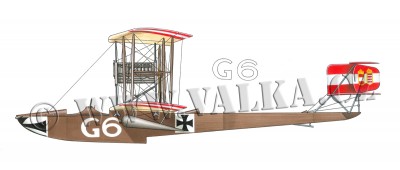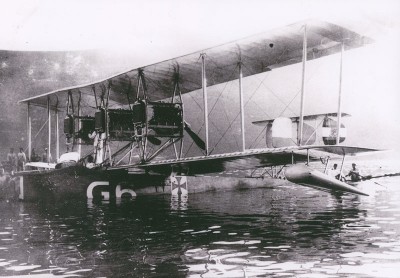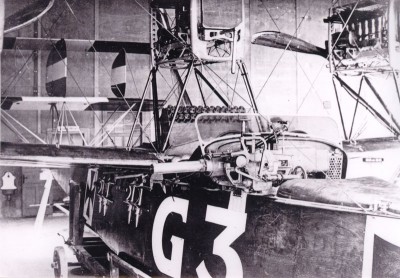| Název: Name: | Flugboot Typ G | Flugboot Type G |
| Originální název: Original Name: | Flugboot Type G | |
| Kategorie: Category: | protiponorkový/protilodní letoun | aeroplane for anti-submarine/anti-ship warfare |
| Výrobce: Producer: | DD.MM.1915-DD.MM.1916 Oesterreichisch-Ungarische Albatros-Flugzeugwerke GmbH, Wien-Stadlau DD.MM.1916-DD.MM.1916 Oesterreichische Flugzeugfabrik AG, Wiener Neustadt | |
| Období výroby: Production Period: | DD.MM.1915-DD.MM.1916 | |
| Vyrobeno kusů: Number of Produced: | 9-12 | |
| První vzlet: Maiden Flight: | DD.11.1915 | |
| Osádka: Crew: | 3 | |
| Základní charakteristika: Basic Characteristics: | ||
| Vzlet a přistání: Take-off and Landing: | CTOL - konvenční vzlet a přistání | CTOL - conventional take-off and landing |
| Uspořádání křídla: Arrangement of Wing: | dvouplošník | biplane |
| Uspořádání letounu: Aircraft Concept: | klasické | conventional |
| Podvozek: Undercarriage: | pevný | fixed |
| Přistávací zařízení: Landing Gear: | člunový trup | flying boat |
| Technické údaje: Technical Data: | ||
| Hmotnost prázdného letounu: Empty Weight: | ? kg | ? lb |
| Vzletová hmotnost: Take-off Weight: | ~4000 kg | ~8800 lb |
| Maximální vzletová hmotnost: Maximum Take-off Weight: | ? kg | ? lb |
| Rozpětí: Wingspan: | ~24,36 m | ~79ft 11in |
| Délka: Length: | ~17,10 m | ~56ft 1in |
| Výška: Height: | ~5,46 m | ~17ft 11in |
| Plocha křídla: Wing Area: | ? m2 | ? ft2 |
| Plošné zatížení: Wing Loading: | ? kg/m2 | ? lb/ft2 |
| Pohon: Propulsion: | ||
| Kategorie: Category: | pístový | piston |
| Počet motorů: Number of Engines: | 3 | |
| Typ: Type: | G1-G3: Hiero o výkonu 110 kW/150 k G4-G7: Austro-Daimler AD6 série 18000 o výkonu 136 kW/185 k G8-G9: Hiero o výkonu 169 kW/230 k | G1-G3: Hiero, power 148 hp G4-G7: Austro-Daimler AD6 series 18000, power 182 hp G8-G9: Hiero, power 227 hp |
| Objem palivových nádrží: Fuel Tank Capacity: | ? | ? |
| Výkony: Performance: | ||
| Maximální rychlost: Maximum Speed: | 110 km/h v ? m | 68.4 mph in ? ft |
| Cestovní rychlost: Cruise Speed: | ? km/h v ? m | ? mph in ? ft |
| Rychlost stoupání: Climb Rate: | ? m/s | ? ft/min |
| Čas výstupu na výšku: Time to Climb to: | 45 min do 600 m | 45 min to 1969 ft |
| Operační dostup: Service Ceiling: | ? m | ? ft |
| Dolet: Range: | ? km | ? mi |
| Maximální dolet: Maximum Range: | ? km | ? mi |
| Výzbroj: Armament: | 1x pohyblivý kanon ráže 66 mm d/20 na přídi - pouze první stroje 1x pohyblivý kulomet na hřbetě - 600-800 kg pum | 1x flexible 66 mm D/20 cannon in the nose - early machines only 1x flexible machine gun amidshps - late machines only 1320-1760 lb of bombs |
| Uživatelské státy: User States: | | |
| Poznámka: Note: | - data platí pro stroje z počátku výroby, pozdější stroje měly trup dlouhý přibližně 18,85 m | - |
| Zdroje: Sources: | http://www.kuk-kriegsmarine.at/seeflieger3.htm www.theaerodrome.com www.theaerodrome.com riseofflight.com | |
Oeffag G
Oeffag-Mickl G
Grosskampfflugboot G
At the turn of the years 1914 and 1915 began to build in the Pulském arsenal (Seearsenal Pola) large flying boats under the designation Grosskampfflugboot (Large seaplane), abbreviated Flugboot G (Seaplane type G or how at the time, the English called Hydroavion G). The whole project šéfoval Linienschiffsleutnant Maschinenbauingenieur 2. Klasse der Reserve Josef Mickl. Ing Josef Mickl was also a marine pilot. Project třímotorového the aircraft was at that time a whopping.
According to the original design Depicted on the Joseph Mickla, submitted and approved admiralitou, was to be built třímotorový flying boat, carrying two of the torpedo or 800 kg of bombs and was preparing to take to arm hydroavion a cannon of the caliber of 66 mm. The cannon for this aircraft is developed and produced in the pilsen škoda auto. It was a cannon caliber 66 mm (d/20. Cannon armament was about 400 kg lighter than the torpedoes and bombs, but the recoil could destroy the skeleton of the hydroavionu. And also the caliber of 66 mm and his penetrator grenades weighing 5 kg could not threaten the more a ship than a torpedo boat. One could, with well secvičenou the crew of the aircraft easily maneuver and destroy their cannons or machine guns. Already before the completion of the prototype in the summer of 1915, it was decided to refrain from arming hydroavionu torpédy and use it to destroy enemy ships, only shooting 66 mm cannon. The first prototype under the designation G-1 was finished in the autumn of 1915.
The prototype with the designation G-1 in test flight 23. November 1915 crashing. Before landing with the Hydroavionu G 1 ripped off the top wing and hydroavion crashed into the Pulského port. The main pilot, former commander of naval air force, Linienschiffsleutnant Hugo Ockermüller died, the second pilot Gottfried Freiherr von Banfield and the mechanic Havelka were severely injured.
Despite this disaster, the construction of the prototypes continued. Used motors to drive the hydroavionu with take-off weight without the arms of over of 4000 kg was not enough. Hydroavion reached a maximum speed of 110 km/h and to a maximum of 600 m was 45 minutes. In 1916, namontovaly more powerful the propulsion unit of Daimler, but even this may significantly help (more powerful engines in 1916 in Germany and Austria did not exist). Hydroavion still had the bad flight characteristics and there was also poor strength of the airframe in flight weight of over 4 tonnes. The materials used and the technology of that time, unfortunately, more could not.
The second disaster has occurred after a year of testing other prototypes. Day 6. November 1916 disaster befell the prototype Hydroavion G 5 and the entire crew. After the ceremony of the start of the Pulské of the bay hydroavion crashed over Fažanským the channel and landed on the coast. In the ruins of the hydroavionu died Linienschiffsleutnant Gustav Klasing, Fregattenleutnant Hely Nicora, Fregattenleutnant Stanislav the ka'ba (*1893, Stanislav the ka'ba was Czech, he joined the navy in 1912 as a naval aspirant).
Only after the project has been velkohydroavionu stopped and the other 8 prototypes have been repealed.
In the number of constructed prototypes with resources diverge, according to one was built 9 prototypes, according to the other 10 or up to 12 pieces.
Technical data:
Margin 28m
The length of the ?
Flight weight, without armament of 4 000kg
The power unit 3x hiero's about the performance of the 150 (112 kW), later 3x Austro-Daimler on the performance of 210k (158 kW)
Notes:
Fregattenleutnant – frigate lieutenant – lieutenant commander
Linienschiffsleutnant – lieutenant of the squadron of ships – captain
Maschinenbauingenieur – mechanical engineer
Resources:
Under the Austrian flag, Jindřich Marek, World of Wings, 2003, ISBN-80-86808-03-3
www.palba.cz
www.austro-hungarian-army.co.uk
Their own notes.
At the turn of the years 1914 and 1915 began to build in the Pulském arsenal (Seearsenal Pola) large flying boats under the designation Grosskampfflugboot (Large seaplane), abbreviated Flugboot G (Seaplane type G or how at the time, the English called Hydroavion G). The whole project šéfoval Linienschiffsleutnant Maschinenbauingenieur 2. Klasse der Reserve Josef Mickl. Ing Josef Mickl was also a marine pilot. Project třímotorového the aircraft was at that time a whopping.
According to the original design Depicted on the Joseph Mickla, submitted and approved admiralitou, was to be built třímotorový flying boat, carrying two of the torpedo or 800 kg of bombs and was preparing to take to arm hydroavion a cannon of the caliber of 66 mm. The cannon for this aircraft is developed and produced in the pilsen škoda auto. It was a cannon caliber 66 mm (d/20. Cannon armament was about 400 kg lighter than the torpedoes and bombs, but the recoil could destroy the skeleton of the hydroavionu. And also the caliber of 66 mm and his penetrator grenades weighing 5 kg could not threaten the more a ship than a torpedo boat. One could, with well secvičenou the crew of the aircraft easily maneuver and destroy their cannons or machine guns. Already before the completion of the prototype in the summer of 1915, it was decided to refrain from arming hydroavionu torpédy and use it to destroy enemy ships, only shooting 66 mm cannon. The first prototype under the designation G-1 was finished in the autumn of 1915.
The prototype with the designation G-1 in test flight 23. November 1915 crashing. Before landing with the Hydroavionu G 1 ripped off the top wing and hydroavion crashed into the Pulského port. The main pilot, former commander of naval air force, Linienschiffsleutnant Hugo Ockermüller died, the second pilot Gottfried Freiherr von Banfield and the mechanic Havelka were severely injured.
Despite this disaster, the construction of the prototypes continued. Used motors to drive the hydroavionu with take-off weight without the arms of over of 4000 kg was not enough. Hydroavion reached a maximum speed of 110 km/h and to a maximum of 600 m was 45 minutes. In 1916, namontovaly more powerful the propulsion unit of Daimler, but even this may significantly help (more powerful engines in 1916 in Germany and Austria did not exist). Hydroavion still had the bad flight characteristics and there was also poor strength of the airframe in flight weight of over 4 tonnes. The materials used and the technology of that time, unfortunately, more could not.
The second disaster has occurred after a year of testing other prototypes. Day 6. November 1916 disaster befell the prototype Hydroavion G 5 and the entire crew. After the ceremony of the start of the Pulské of the bay hydroavion crashed over Fažanským the channel and landed on the coast. In the ruins of the hydroavionu died Linienschiffsleutnant Gustav Klasing, Fregattenleutnant Hely Nicora, Fregattenleutnant Stanislav the ka'ba (*1893, Stanislav the ka'ba was Czech, he joined the navy in 1912 as a naval aspirant).
Only after the project has been velkohydroavionu stopped and the other 8 prototypes have been repealed.
In the number of constructed prototypes with resources diverge, according to one was built 9 prototypes, according to the other 10 or up to 12 pieces.
Technical data:
Margin 28m
The length of the ?
Flight weight, without armament of 4 000kg
The power unit 3x hiero's about the performance of the 150 (112 kW), later 3x Austro-Daimler on the performance of 210k (158 kW)
Notes:
Fregattenleutnant – frigate lieutenant – lieutenant commander
Linienschiffsleutnant – lieutenant of the squadron of ships – captain
Maschinenbauingenieur – mechanical engineer
Resources:
Under the Austrian flag, Jindřich Marek, World of Wings, 2003, ISBN-80-86808-03-3
www.palba.cz
www.austro-hungarian-army.co.uk
Their own notes.
Reklama
This post has not been translated to English yet. Please use the TRANSLATE button above to see machine translation of this post.
| Period | World War One / The Great War [1914-1918] |
| Producer | Oeffag |
| Type | Oeffag G |
| Camouflage | Standardní vojenská |
 Plátno / Fabric Plátno / Fabric Dřevo / Wood Dřevo / Wood |
|
| Country |  |
| Pilot | - |
| Production No. | - |
| Serial No. / Evidence No. | G 6 |
| Tactical Marking / Imatriculation | G 6 |
| Name | - |
| Unit | - |
| Base | - |
| Date (DD.MM.RRRR) | DD.MM.RRRR |
| Author | Zbyněk Válka |
| Print size / 300 DPI | A4 |
| Published with authors permit | Published with authors permit |
| Author Website | - |
Obří třímotorový létající člun Mickl vyrobený firmou Oeffag. Stroj létal v barvě materiálu. Kříže byly pouze na horní straně horního křídla a spodní straně dolního křídla. Zajímavostí jsou oba erby (rakouský i uherský) na směrovce.
Published with authors permit
[source]riseofflight.com].
| Period | World War One / The Great War [1914-1918] |
| Producer | Oeffag |
| Type | Oeffag G |
| Camouflage | Standardní vojenská |
 Plátno / Fabric Plátno / Fabric Dřevo / Wood Dřevo / Wood |
|
| Country |  |
| Pilot | - |
| Production No. | - |
| Serial No. / Evidence No. | G 6 |
| Tactical Marking / Imatriculation | G 6 |
| Name | - |
| Unit | - |
| Base | - |
| Date (DD.MM.RRRR) | DD.MM.RRRR |
| Author | - |
| Print size / 300 DPI | - |
| Published with authors permit | - |
| Author Website | - |
riseofflight.com
.| Period | World War One / The Great War [1914-1918] |
| Producer | Phönix |
| Type | Oeffag G |
| Camouflage | Standardní vojenská |
 Plátno / Fabric Plátno / Fabric Dřevo / Wood Dřevo / Wood |
|
| Country |  |
| Pilot | - |
| Production No. | - |
| Serial No. / Evidence No. | G 3 |
| Tactical Marking / Imatriculation | G 3 |
| Name | - |
| Unit | - |
| Base | - |
| Date (DD.MM.RRRR) | DD.MM.RRRR |
| Author | - |
| Print size / 300 DPI | - |
| Published with authors permit | - |
| Author Website | - |
Kanon v přídi G3. Následující stroje ho pravděpodobně již neměly.
Reklama
Join us
We believe that there are people with different interests and experiences who could contribute their knowledge and ideas. If you love military history and have experience in historical research, writing articles, editing text, moderating, creating images, graphics or videos, or simply have a desire to contribute to our unique system, you can join us and help us create content that will be interesting and beneficial to other readers.
Find out more

